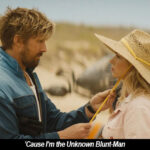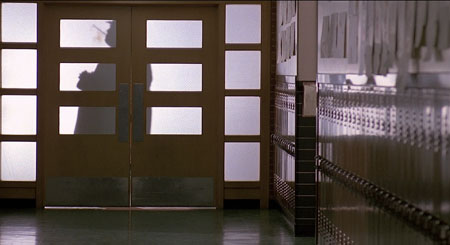***½/**** Image B- Sound B Extras B
starring Mike White, Chris Weitz, Lupe Ontiveros, Beth Colt
screenplay by Mike White
directed by Miguel Arteta
by Travis Mackenzie Hoover Can a film be unpleasant and valuable at the same time? On the one hand, I was made truly uncomfortable by Chuck & Buck, which centres on a character so obnoxious and so deluded that he would hardly be tolerated in polite society. His single-minded obsession with a man with whom he had a childhood friendship is so invasive and toxic that he repeatedly strains audience sympathy; further, it traps us in his myopic point of view and makes us watch in horror as he plans another assault on his former friend’s life, for the sake of some deeply confused homoerotic desires that he can barely articulate. And yet, I found myself profoundly moved at the end of this singular film, which never wavers in its unconditional love for its screwed-up protagonist and seeks for him a place in the world that he sadly cannot make for himself. I don’t exactly know what I can do with the information it gives me about this man, but I can certainly say that Chuck & Buck gave me more of an experience than the majority of fireballing studio products from 2000.
The film deals with Buck (Mike White, who also wrote the screenplay), a man whose development was arrested at about age eleven. His room is festooned with carefully arranged toys and knick- knacks, he is seldom seen without a sucker in his mouth, and he is fixated on a childhood friend named Chuck who moved away when they were both kids. Early on in the film, his mother dies, and he writes Chuck to come to the funeral. Out of some sense of duty, Chuck (Chris Weitz), now known as Charlie, goes to pay his respects with his fiancee in tow, and gets the shock of his life: Buck has carried a torch for him for so long that he clings to him desperately, at one point groping him in the bathroom. At this point, Charlie opts to flee Buck and flies back to his L.A. job as a music producer, but Buck follows him to California and begins to stalk him, not realizing that his constant pursuit is reducing his chances of winning him back.
While on his daily routine of waiting outside the office for Charlie, he encounters a small theatre that specializes in kiddie plays, and he is inspired: he will write a play about their relationship and prove his love that way. He pays the theatre’s house director (Lupe Ontiveros) to direct and they assemble a cast, including a terrible actor (Paul Weitz) who bears a resemblance to Buck’s beloved friend, and arranges to have it performed for one night only, specifically for the edification of Charlie and his fiancee (Beth Colt). But the ploy, of course, backfires, and he is pushed even further outside of Charlie’s circle than before. Reduced to nothing, Buck has no recourse but to pester him even more, until Charlie grants him, for one night, the wish he’s had since childhood but needs satisfying now.
Reading those last two paragraphs, it’s hard to see what could possibly be sympathetic about a guy like Buck. He’s unbalanced, socially inept, hostile and fixated on something he can’t have, resulting in a monomaniacal mission that threatens the privacy of his former friend. What’s to like? But the surprise of Chuck & Buck is that it is largely an act of kindness towards Buck’s point of view, privileging the feelings that surge within him even as it acknowledges the disasters that those feelings create. The film has an unusual relationship with him, both refusing to explain his motives beyond Charlie’s assertion that his parents were “crazy” and yet allowing us to feel the pain welled up inside him. As it deals with his actions almost exclusively, we are allowed to be both subject and object at the same time, as much deeply hurt by his many rejections while being appalled by his creepy behaviour. Chuck & Buck is a very unusual narrative film in that it leads us inside and outside of identification at the same time.
The question is, where does it leave us? Buck is such a unique character that he pretty much transcends any stab at social explanation or identity politics. The film is as in the dark about what drives Buck as much as the audience is, and yet it soldiers on as though the story were somehow deeply important–which, for all I know, it may be. Even his infatuation with Charlie is never treated as typical or normal gay behaviour, wrapped up as it is in mitigating circumstances involving his parentage and the frenzied, passionate relationship the two men had when they were boys. I would be saying too much to divulge the full extent of this relationship, which goes a long way to explaining the reasons for his sexual feelings, but I will say that there are firm, if erroneous, reasons that he feels them; let it be said that Buck has nothing left in his life beyond the one relationship that ever gave him satisfaction. That it makes for a gruelling 90 minutes goes without saying, but even as I acknowledge the film’s impact, I wonder what is really on its mind.
On the other hand, the fact remains that the film’s reading of its characters is totally unlike any doctrinaire position on sexual or other politics that I’ve ever seen. While it’s been floated that the film gives gay rights “a black eye,” as Ingrid Randoja reported in Toronto’s “NOW” magazine, the truth is a great deal more complicated. The film boldly acknowledges the sexuality of children and the experiments which result in it, and affirms a kind of polysexuality in those years before one makes choices about sexual identity. Buck, as regressive as he might seem, is defiant in his reluctance to relinquish his own identity, even as he is spurned by the object of his desire. While he has gotten this tangled up so badly that he can’t articulate what his motives truly are, he is such a marginalized character that it’s hard to shake the feeling that the film is onto something. But what, exactly? One could write a dissertation on Buck’s psychological profile, so unusual is it; while it doesn’t have any explanation it is successful in scrambling everything you thought you knew about sexuality, and if nothing else will inspire you to redefine the sexual world in which we live.
The film is ultimately so protective of its hero that it fudges a few things for mercy’s sake. People (aside from Charlie) are just too willing to help a man who in real life would be completely shunned. Charlie’s fiancee is especially indulgent, feeling so sorry for him that she has lunch with him in order to get him some professional help; this, even after she has seen his bizarre play where she has been characterized as a green-faced witch. Furthermore, the director he enlists to realize his play is far too tolerant; I realize that he’s paying her in cash, but he is allowed to hang around the theatre after his theatrical fiasco when any other human being would probably have nothing further to do with him. But it’s easy to overlook these gaffes, because it’s part of the film’s program to bring an end to Buck’s pain. Unpleasant as it may be to witness, the film is ultimately affirmative, allowing him to settle down in some sort of halfway house between his madness and the world, and if it errs on the side of charity it’s still a hell of a lot more uplifting than most of the contrivances that normally masquerade as American films. Originally published: August 9, 2000.
by Bill Chambers As with Artisan Entertainment’s last much-hyped Sundance acquisition, the Digital Video-shot Chuck & Buck has been transferred to DVD from its 35mm blow-up instead of its tape master. I have mixed feelings about this; while I’m no fan of the soap opera texture inherent in the look of video productions, transferring what is essentially a third-generation dupe to DVD fails to realize the format’s potential for high-resolution images. For home viewing, Chuck & Buck (presented anamorphically on DVD at 1.85:1) has been unfortunately ascribed the hazy, blotchy aesthetic of “ABC Afterschool Specials” or early-period VHS. Yet I think I’d prefer this to it resembling the glossiest camcorder movie ever made.
The film’s quiet, dialogue-heavy 2.0 Dolby Surround mix is energized on DVD by bouncy ditties, though there’s never much call for the surrounds or bass channel. The disc also includes generous helpings of bonus material, despite the front cover’s modesty. To begin with, two commentaries occupy separate audio tracks, the first with director Arteta and writer/star White, the second an unusual “insider’s” perspective featuring director’s assistant Ruben Fleischer and key grip Doug Kieffer. Arteta and White (speaking in less whiny tones than his character) are afflicted with the same symptom as the Farrelly Brothers, in that they spend most of their discussion pointing out the friends and relatives who wound up as extras and harping on bad reviews (White is humorously fixated on ENTERTAINMENT WEEKLY’s observation that his face bears a “snaggletooth leer”). Surprisingly, the industry dwellers on the other track betray greater enthusiasm for Chuck & Buck and provide better, if no more insightful, trivia.
Six deleted scenes (in 4:3 but sharp as a tack letterboxed DV), five of them supplemented by optional commentary again from Arteta and White (recorded together, I should probably add), demonstrate the pair’s strong storytelling instincts; what’s removed in the editing process is as integral as what stays in, and had they kept the penultimate omission here, Chuck & Buck probably would’ve left a sour taste in the mouths of even its supporters. (It turns Buck’s “cure” on its ear.) Completing this package is a list of children’s games accompanied by deadpan text instructions for them, the film’s fabulous trailer, cast & crew bios, production notes, and a foldout booklet in which Arteta and cinematographer Chuy Chàvez reflect on the advantages of digital video.
A great, non-judgmental examination of taboo subjects, Chuck & Buck is one of the year’s best movies, DV or otherwise.
97 minutes; R; 1.77:1 (16×9-enhanced); English Dolby Surround; CC; English subtitles; DVD-9; Region One; Artisan

![Chuck & Buck [DVD]](https://m.media-amazon.com/images/I/41cNMy1pryL._SL500_.jpg)





